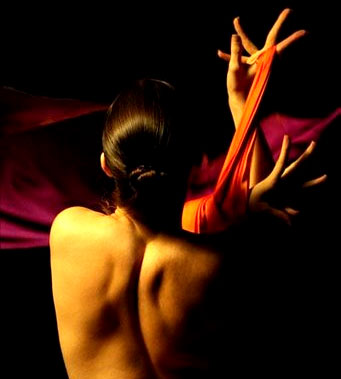
Part of Geoffrey’s Fabrics portfolio. Model: Vanessa Tarachin. Photo by Geoffrey Pereira.
Geoffrey Pereira (left).
Journalist Geoffrey Pereira and I met whilst he was on a visit to Gothenburg, for the World Editor’s Forum that took place in early June, 2008.
It was wonderful meeting a fellow Singaporean on foreign soil and Geoffrey shared that, while managing a small IT department in Singapore Press Holdings, he had cultivated a passion of another sort, one that allowed for self expression beyond words, that of photography.
I had the opportunity to browse through Geoffrey’s themed photography portfolio. The above bare-backed picture of a woman with saturated colour swirls, is one obtained from his Fabrics portfolio, where he experimented with expressing the female form against various types of fabrics, the colours and textures of the fabric contrasting to the pallor of skin.
A portfolio that caught my particular attention was what Geoffrey called his Trash Bag Project, where he worked with cutting and stitching pieces of trash bags to form wearable outfits.
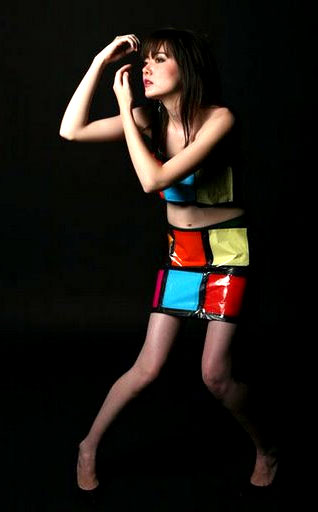
Model: Margaret in block primary colours. Photo and outfit designed / produced by Geoffrey Pereira.
Model: Margaret in dotted primary colours in the form of apples. Photo and outfit designed / produced by Geoffrey Pereira.
I wondered, of the plethora of possibilities and of all paradigmatic choices in textile exploration, why trash bags?
What came to mind personally was early 20th century artists like Hans Arp (1887-1966) and Piet Mondrian (1872-1944). Two artists I just had looked at in the MET and MoMA in New York and also at the Tate Gallery of Modern Art in London. Both stylistically focused on balanced designs and primary colors but fundamentally concerned with questions of hope and hopelessness and if technology will eventually save us or destroy us.
Would not Geoffrey’s Trash Bag Project, with the purchase of inexpensive disposable materials from the grocery store and the subsequent manufacture and draping of these ‘clothes’ on our bodies express the same fears as the early Dadaists of the 20th century? Or as I have referenced in a previous article, Marcel Duchamp and his ready-mades?
But Geoffrey told that it was rather that he was looking to explore planes of expression in photography. He wasn’t really into women as pretty objects:
I was a little tired of the usual type of photo shoot. Bikini, lingerie “high-fashion” and what I call “pretty-pretty” girl photography. I wanted something different.
I personally would not call the trash bag creations “fashion”. Really. If it comes across like that, it’s accidental. But I’m discovering things along the way. I think the way Margaret poses may suggest fashion.
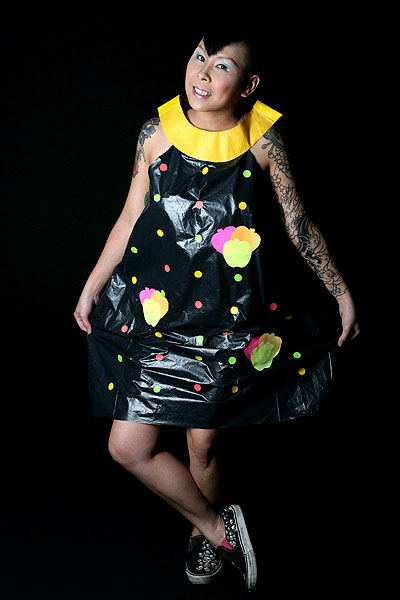
Tough tattooed Louise, in a pretty-girl pose which she calls “irony” and someone else calls weird styling. ~ Geoffrey Pereira.
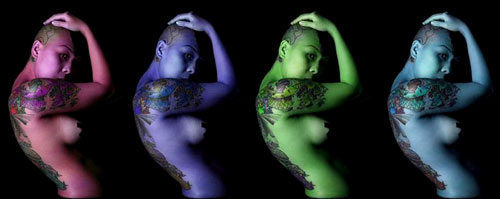
From Geoffrey’s Body Art portfolio, Louise in a different expression, by Geoffrey Pereira.
With Geoffrey’s various expressions via photography and his Trash Bag Project, my mind wandered to the New York painter who literally painted underground, Keith Haring who truly became a recognized artist by accident.
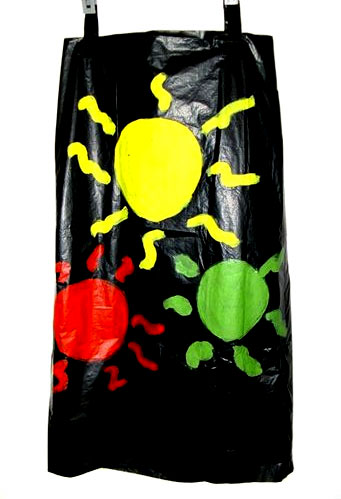
A Keith Haring reminiscent Trash Bag dress and design by Geoffrey Pereira. Photo by Geoffrey Pereira.
Keith Haring worked by painting empty walls in the New York Subways. He looked at the graphic language in public signposts saying things like Ladies Room, Men’s Room, Zebra Stripes as in Walk Here signs, Men at Work etc. and took this explicit public sign language and transferred it into the private and most intimate parts of private live, and eventually went from graffiti to the most famous of the Art Saloons. Clothes being a public statement of our most private feelings, a sublime relation.
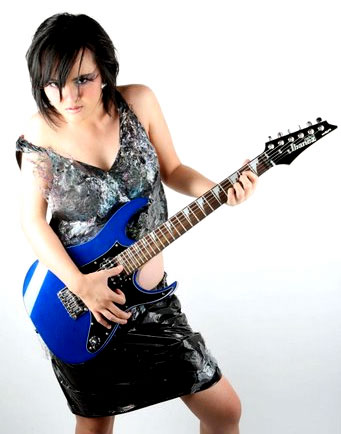
Moving in the likes of Christian Joy? Design and photo by Geoffrey Pereira.
As we talked I discovered that Geoffrey has other upcoming photography sessions and clothes project, to do with exploring parallel themes with other materials such as serviette paper and paper or trash bags in more exotic colours such as purple, green, orange etc. And in this day and age of eco-awareness, perhaps Geoffrey’s ‘disposable wear’ has its place in modern art, which is forward, thought provoking and intriguing. Much perhaps also in the likes of Christian Joy.
And with these thoughts, I couldn’t help but find myself looking forward to an exhibition of Geoffrey Pereira’s work in the near future.
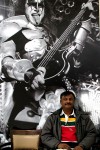
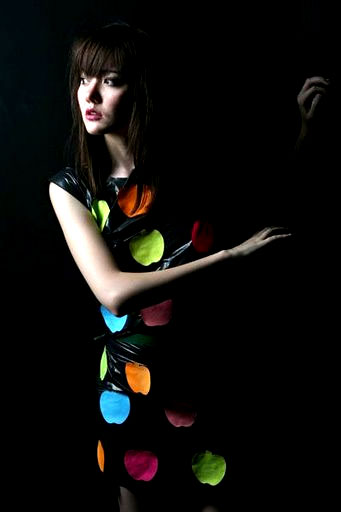
One thought on “Meeting with Geoffrey Pereira: exploring expression in photography”